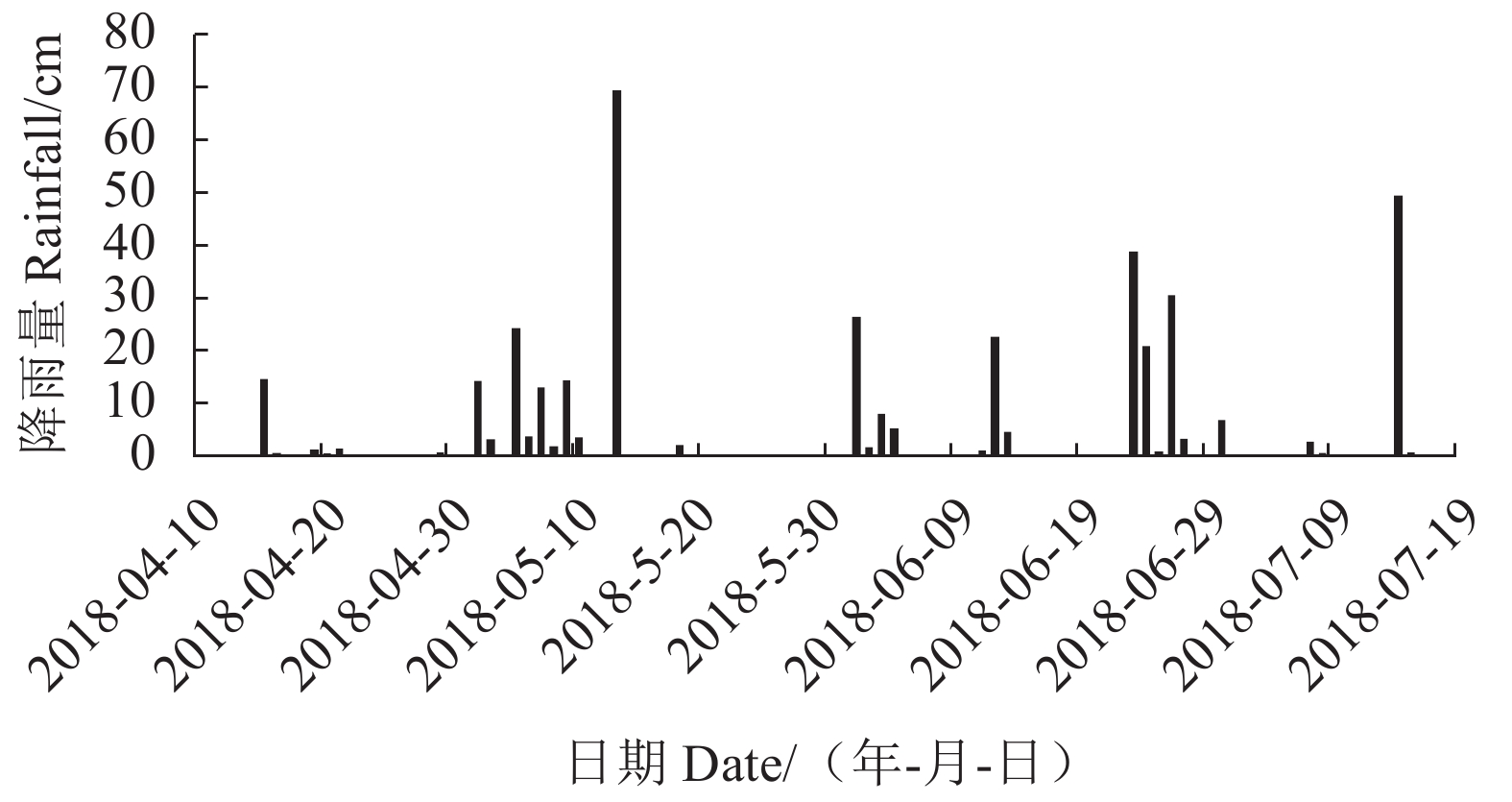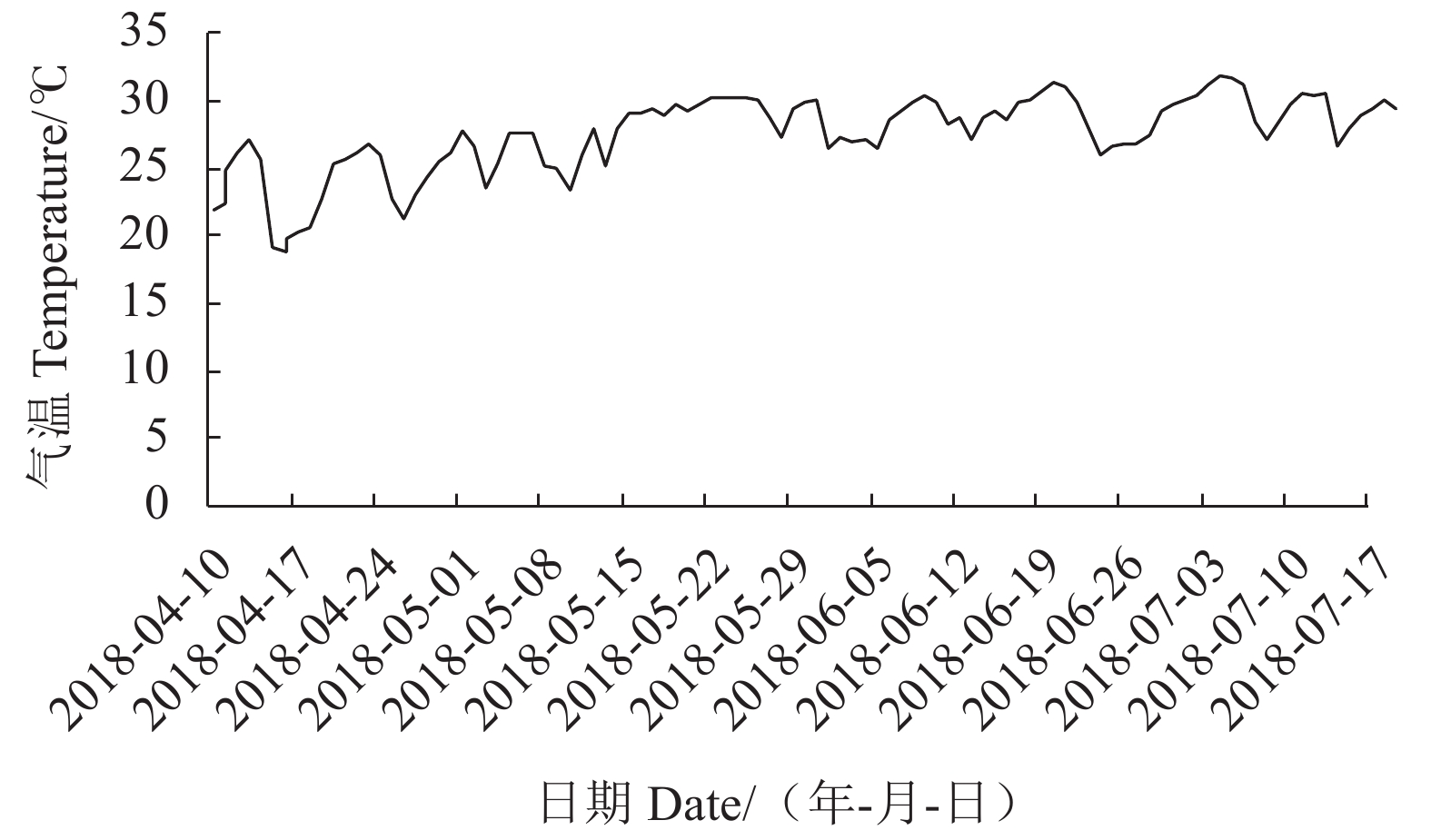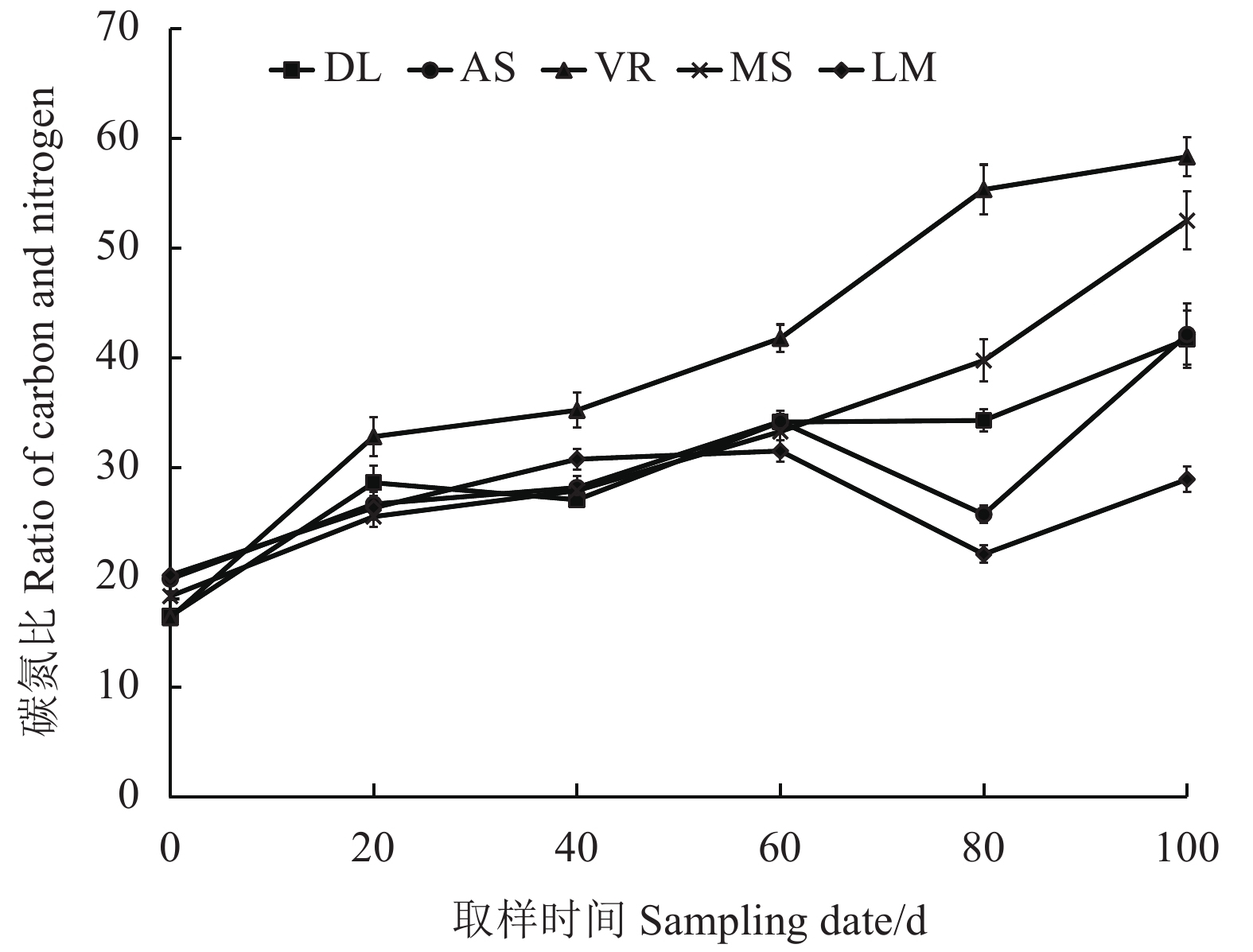Decomposition and Nutrient Release of Five Green Manures in Citrus Field
-
摘要:目的 研究绿肥在柑橘地还田后腐解及养分释放动态特征,为绿肥在橘园的生产和应用提供技术依据。方法 应用尼龙网袋法,在柑橘地采用拉巴豆、紫云英、光叶苕子、紫花苜蓿、黑麦草等5种绿肥进行翻压还田,还田深度为20 cm,并分别于还田后的第20、40、60、80、100 d对5种绿肥样品进行取样,对样品中的碳、氮、磷、钾元素含量进行分析,研究5种绿肥的碳氮比、腐解规律以及养分释放特征。结果 5种绿肥的腐解及养分释放均表现前期(0~20 d)快,中后期(20~100 d)慢的特征。腐解至20 d,5种绿肥腐解率达到35.52%~73.96%,腐解至100 d,腐解率达79.13%~90.25%。腐解至20 d,5种绿肥的C、N、P、K的释放率分别为38.10%~78.59%、66.92%~87.63%、28.60%~80.92%、80.22%~96.72%;腐解至100 d时,5种绿肥的C、N、P、K的释放率分别为80.90%~95.48%、94.63%~97.64、59.66%~96.28%、94.46%~99.64%,养分累计释放率表现为钾>氮>碳>磷。5种绿肥的碳氮比随腐解的进行大致呈现上升的趋势。结论 5种绿肥还田后,紫云英的累计腐解率最高,拉巴豆的N和K累计释放率最高,黑麦草的C和P累计释放率最高。Abstract:Objective Decomposition and nutrient release of green manure after returning to soil in citrus field were studied.Method Using nylon mesh bags to contain Dolichos lablab, Astragalus sinicus, Viciavillosa Rothvar, Medicago sativa, or Lolium multiflorum and plowed into the soil at a depth of 20 cm. Soil samples were taken on the 20th , 40th, 60th, 80th, and 100th day after manure turning over to determine carbon, nitrogen, phosphorus, and potassium contents. Carbon/nitrogen ratio, material degradation, and nutrient release were tabulated for analysis.Result The manure decomposition and nutrient release were at a high rate in 0–20 d after the deposit but slowed down from the 20th to the 100th day. The rate of material decay reached 35.52%–73.96% after 20 d, and 79.13%–90.25% after 100 d. For the 5 green manures, the releases of C, N, P, and K ranged 38.10%–78.59%, 66.92%–87.63%, 28.60%–80.92%, and 80.22%–96.72%, respectively, in 20 d, and 80.90%–95.48%, 94.63%–97.64, 59.66%–96.28%, and 94.46%–99.64%, respectively, in 100 d. The cumulative nutrient release was K>N>C>P, and the C/N ratio increased as the decomposition progressed.Conclusion Among the 5 green manures, A. sinicus displayed the highest cumulative decay rate, D. lablab the most cumulative N and K releases, and L. multiflorum the greatest cumulative C and P releases.
-
Keywords:
- green manure /
- returning to soil /
- decomposition /
- nutrient release
-
0. 引言
【研究意义】我国是世界上绿肥种植年限最长、面积最大、范围最广的国家。然而,随着化肥的推广应用,绿肥种植面积迅速减少,过量施用化肥以及不合理的耕作模式导致土壤环境逐渐恶化[1]。目前,柑橘在广西的种植面积已超过40万hm2,种植户单纯追求产量,导致过度依赖化肥,其肥料利用率低,生产成本居高不下,且果品质量欠佳,制约了柑橘产业的可持续发展[2]。绿肥作为一种清洁的有机肥源,压青还田后在改善土壤化学及生物学性状,促进对主栽作物的养分供给和保障作物稳产、高产方面具有明显优势[3-4]。因此,在柑橘园种植和利用绿肥,提高土壤肥力、改善橘园土壤环境是推进农业绿色发展的重要方式。【前人研究进展】前人利用尼龙网袋法、同位素标记法、红外光谱法和13C核磁共振法等手段掌握了绿肥作物的腐解方法[5]。绿肥还田后秸秆腐解及养分释放过程受绿肥作物自身化学性质、环境条件以及田间管理措施等[5]多种因素影响,其腐解过程主要分为快速腐解期、缓慢腐解期和腐解停滞期[6-7]。而养分矿化速率不同的主要原因是绿肥茎秆中钾元素以K+存在于细胞中或植物组织内,很容易被水浸提而快速释放,磷、氮和碳等则以难分解的有机态为主,在物理作用下分解释放较慢[8]。【本研究切入点】近年来,拉巴豆(Dolichos lablab)作为多年生绿肥,紫云英(Astragalus sinicus)、光叶苕子(Viciavillosa rothvar)、紫花苜蓿(Medicago sativa)、黑麦草(Lolium multiflorum)等作为冬季绿肥在广西柑橘园行间种植并应用推广[9],但这5种绿肥在柑橘地的腐解和养分释放还鲜有报道。【拟解决的关键问题】本研究采用尼龙网袋法,研究拉巴豆、紫云英、光叶苕子、紫花苜蓿、黑麦草在柑橘园行间还田后的腐解情况,分析其腐解规律和养分释放动态特征,为橘园绿肥的合理利用和柑橘养分管理提供科学依据。
1. 材料与方法
1.1 试验材料
试验开展于广西南宁市义平水果种植专业合作社柑橘基地,该地属亚热带季风气候,年平均气温21.6 ℃,东经108°5′、北纬23°1′,海拔255 m。柑橘品种为沃柑,绿肥品种为多年生豆科绿肥:拉巴豆(DL);冬季豆科绿肥:紫云英(AS)、光叶苕子(VR)、紫花苜蓿(MS);冬季禾本科绿肥:黑麦草(LM)。绿肥种质资源来源于广西农业科学院农业资源与环境研究所,均为同批次,干基养分含量见表1。试验地土壤类型为红壤,基本理化性质为:碱解氮86.3 mg·kg−1,有效磷7.5 mg·kg−1,速效钾96 mg·kg−1,有机质18.67 g·kg−1,pH5.7。试验地在试验期间的降雨量见图1,平均气温见图2。
表 1 供试绿肥的含水率及碳、氮、磷、钾养分含量Table 1. Contents of water, C, N, P, and K in 5 green manures绿肥品种
Green manure varieties含水率
Moisture content/%全碳
Carbon/%全氮
Nitrogen/%全磷
Phosphorus/%全钾
Potassium/%碳氮比
Ratio of carbon and nitrogen拉巴豆 Dolichos lablab 76.5 46.25 2.81 0.64 3.15 16.46 紫云英 Astragalus sinicus 84.52 45.27 2.82 0.36 2.74 16.05 光叶苕子 Viciavillosa Rothvar 85.00 39.85 2.44 0.29 3.08 16.33 紫花苜蓿 Medicago sativa 75.79 44.37 2.43 0.22 2.08 18.26 黑麦草 Lolium multiflorum 83.64 42.87 2.12 0.72 3.87 20.22 1.2 试验设计
5种绿肥均于2017年10月下旬种植,于2018年4月10日对5种绿肥进行收割,将地上部分切成2 cm小段,混匀后装入尼龙网袋,每袋装入200 g,将袋展平、封好口袋,在柑橘两行之间的小区内翻压绿肥,还田深度为20 cm,间距为30 cm。根据李帅等方法[10],还田后第0、20 、40 、60 、80 、100 d进行取样,即当年7月19日试验结束。每次每种绿肥处理取3袋,样品取回后用蒸馏水冲洗干净,烘干称其质量、磨碎后测定碳、氮、磷、钾含量。
1.3 指标测定
植物样全碳含量采用重铬酸钾容量法-外加热法测定,样品经浓硫酸-过氧化氢消解后,采用凯氏定氮法测定全氮含量,用钒钼黄比色法测定全磷含量,采用火焰光度计法测定全钾含量。
1.4 数据处理与统计
本文数据处理中均以干样进行计算。利用Microsoft Excel软件进行数据处理和绘图,用SPSS22.0进行方差分析。
累积腐解量(g)=m0−mt (1) 平均腐解速率(g⋅d−1)=(m0−mt)/t (2) 累积腐解率(%)=[(m0−mt)/m0]×100% (3) 养分累积释放率(%)=[(w0−wt)/w0]×100% (1) 式中,m0为绿肥初始干物质量,mt为翻压t天的绿肥干物质量;w0为绿肥初始养分含量,wt为翻压t天的绿肥养分含量。
2. 结果与分析
2.1 绿肥腐解特征
经过100 d的腐解试验,结果表明(表2):拉巴豆的累计腐解量在整个腐解阶段均为全组最高,且显著高于其他处理(P<0.05)。5种绿肥的腐解分为前期快速腐解期(0~20 d)和中后期的缓慢腐解期(20~100 d)。前20 d,5种绿肥的腐解速率达0.53~1.74 g·d −1,到了第20~40 d则降至0.06~0.31 g·d −1,随后2次取样结果表明,5种绿肥的腐解速率依旧较低,但到了第80~100 d,5种绿肥腐解速率均有所升高,这可能与该时间段(7月份)气温高有关,根据当地气象局提供的数据显示,第80~100 d的腐解期平均气温为整个试验期的最高(图1)。
表 2 不同绿肥腐解量、腐解速率及腐解率Table 2. Quantity, speed, and rate of manure decomposition绿肥品种
Green manure varieties拉巴豆
Dolichos lablab紫云英
Astragalus sinicus光叶苕子
Viciavillosa Rothvar紫花苜蓿
Medicago sativa黑麦草
Lolium multiflorum累计腐解量
Accumulative decomposition amount/g第20 d
The 20th day34.76±0.10 a 21.09±0.24 c 10.66±0.16 e 23.29±0.22 b 16.64±1.11 d 第40 d
The 40th day35.92±0.65 a 21.84±0.63 c 16.17±2.54 d 29.45±3.65 b 20.37±1.56 c 第60 d
The 60th day37.75±0.58 a 23.93±0.04 c 18.57±0.90 d 32.00±3.95 b 23.98±0.25 c 第80 d
The 80th day39.40±0.96 a 25.28±0.05 c 20.05±0.43 d 33.85±3.32 b 25.40±0.75 c 第100 d
The 100th day42.10±0.20 a 27.94±0.25 d 23.74±0.75 e 40.98±0.22 b 30.33±0.47 c 腐解速率
Decomposing speed/(g·d −1)第20 d
The 20th day1.74±0.01 a 1.05±0.02 b 0.53±0.01 d 1.16±0.02 b 0.83±0.09 c 第40 d
The 40th day0.06±0.02 bc 0.04±0.01 c 0.28±0.06 a 0.31±0.12 a 0.19±0.06 abc 第60 d
The 60th day0.09±0.01 a 0.10±0.02 a 0.12±0.05 a 0.13±0.01 a 0.18±0.04 a 第80 d
The 80th day0.08±0.01 a 0.07±0.00 a 0.07±0.02 a 0.09±0.02 a 0.07±0.02 a 第100 d
The 100th day0.13±0.02 b 0.13±0.06 b 0.18±0.02 b 0.36±0.09 a 0.25±0.01 ab 腐解率
Decomposing rate/%第20 d
The 20th day73.96±0.35 a 68.11±1.23 a 35.52±0.82 c 48.11±0.71 b 50.86±5.34 b 第40 d
The 40th day76.43±0.80 a 70.55±1.12 ab 53.90±4.88 c 60.82±4.35 bc 62.25±2.76 bc 第60 d
The 60th day80.33±0.71 a 77.28±0.08 a 61.90±1.73 b 66.09±4.59 b 73.28±2.02 a 第80 d
The 80th day83.84±1.18 a 81.66±0.09 a 66.82±0.83 b 66.92±3.97 b 77.63±1.31 a 第100 d
The 100th day89.57±0.24 a 90.25±0.46 a 79.13±1.45 c 84.64±0.26 b 87.03±2.12 ab 注:不同小写字母之间表示同一取样批次不同绿肥的试验结果之间有显著差异(P<0.05),下表同。
Note: Data with different lowercase letters indicate significant differences in same sampling batch (P<0.05). Same for following tables.腐解率方面,5种绿肥的腐解均较为彻底,这与本试验地高温多雨有关,试验期间,试验地平均气温达27.68 ℃(图1),日平均降雨量达到4.15 mL(图2)。其中,腐解至20 d,5种绿肥的腐解率达到35.52%~73.96%,腐解至100 d,其腐解率分别达79.13%~90.25%。在前4次取样中,拉巴豆的腐解率均为最高,第100 d取样时,紫云英的腐解率为全组最高。5种绿肥累计腐解率分别表现为紫云英>拉巴豆>黑麦草>紫花苜蓿>光叶苕子,紫云英和拉巴豆累计腐解率显著高于光叶苕子和紫花苜蓿。因此,5种绿肥的累计腐解量最高为拉巴豆,累计腐解率最高的为紫云英,光叶苕子的累计腐解量及腐解速率均为全组最低。
2.2 碳释放特征
由表3可知,5种绿肥的碳释放均大致表现出0~20 d释放快,20~100 d相对较慢的特征,但不同绿肥之间仍有较大差异。腐解至20 d时,拉巴豆、紫云英、光叶苕子、紫花苜蓿、黑麦草的碳累计释放率分别为78.59%、72.99%、38.10%、53.93%、56.82%,拉巴豆和紫云英的碳累计释放率显著高于其余几组(P<0.05)。腐解至100 d时,5种绿肥碳累计释放率表现为黑麦草>拉巴豆>紫云英>紫花苜蓿>光叶苕子,分别达到95.48%、94.06%、92.58%、86.69%、80.90%,除拉巴豆外,黑麦草的碳累计释放率显著高于其余几组,光叶苕子的累计释放率均为全组最低。
表 3 不同绿肥碳释放特征Table 3. C releases of 5 green manures绿肥品种
Green manure varieties碳释放率 Release rates of C/% 第20 d
The 20th day第40 d
The 40th day第60 d
The 60th day第80 d
The 80th day第100 d
The 100th day拉巴豆 Dolichos lablab 78.59±0.17 a 83.21±0.63 a 85.28±0.66 a 89.80±0.85 a 94.06±0.17 ab 紫云英 Astragalus sinicus 72.99±1.70 a 76.59±1.08 a 81.11±0.17 ab 90.28±0.02 a 92.58±0.31 b 光叶苕子 Viciavillosa Rothvar 38.10±1.55 c 56.55±4.97 c 63.80±2.10 d 68.11±0.72 c 80.89±1.55 d 紫花苜蓿 Medicago sativa 53.93±1.26 b 67.04±3.54 b 71.27±3.60 c 75.46±2.98 b 86.69±0.34 c 黑麦草 Lolium multiflorum 56.82±4.18 b 66.83±1.95 b 77.85±0.29 c 87.92±0.62 a 95.48±0.53 a 2.3 氮释放特征
如表4可知,5种绿肥还田后,氮的释放在0~20 d较为迅速。腐解至20 d,5种绿肥的氮累计释放率均高于60%,其中,拉巴豆、紫云英、光叶苕子、紫花苜蓿、黑麦草的氮释放率分别达到87.63%、79.94%、69.04%、66.92%、66.99%,拉巴豆的氮释放率为全组最高,显著高其余几组(P<0.05)。试验结束时,5种绿肥氮释放较为彻底,累计释放率均高于90%,5种绿肥氮累计释放率表现为拉巴豆>黑麦草>紫云英>紫花苜蓿>光叶苕子,分别达到97.64%、96.73%、96.48%、95.35%、94.63%。拉巴豆的氮累计释放率均为全组最高,光叶苕子为全组最低。
表 4 不同绿肥氮释放率特征Table 4. N releases of 5 green manures绿肥品种
Green manure varieties氮释放率 Release rates of N/% 第20 d
The 20th day第40 d
The 40th day第60 d
The 60th day第80 d
The 80th day第100 d
The 100th day拉巴豆 Dolichos lablab 87.63±0.42 a 89.79±0.35 a 92.89±0.43 a 95.12±0.24 a 97.64±0.12 a 紫云英 Astragalus sinicus 79.94±0.71 b 83.54±0.50 b 89.04±0.13 ab 92.50±0.11 ab 96.48±0.28 ab 光叶苕子 Viciavillosa Rothvar 69.04±1.80 c 80.01±1.31 bc 85.89±0.31 bc 90.60±0.21 bc 94.63±0.52 c 紫花苜蓿 Medicago sativa 66.92±1.79 c 78.40±2.30 c 83.92±2.92 c 88.55±1.96 c 95.35±0.20 c 黑麦草 Lolium multiflorum 66.98±2.28 c 78.15±1.69 c 85.80±0.26 bc 88.96±0.51 c 96.85±0.32 ab 2.4 磷释放特征
由表5可知,磷的释放也表现出前期快(0~20 d),中后期(20~100 d)慢的特征,但不同绿肥之间仍有较大差异。腐解20 d时,拉巴豆、紫云英、光叶苕子、紫花苜蓿、黑麦草的磷累计释放率分别为80.92%、49.90%、41.39%、28.60%、78.85%,此时拉巴豆的磷累计释放率最高,较磷累计释放率最低的紫花苜蓿高出182.93%。腐解至100 d时,5种绿肥磷累计释放率表现为黑麦草>拉巴豆>紫云英>光叶苕子>紫花苜蓿,分别达96.28%、95.70%、83.50%、66.85%、59.66%。可能与绿肥初始磷含量有关,拉巴豆和黑麦草在整个腐解期间的释放率都显著高于另外几种绿肥(P<0.05)。
表 5 不同绿肥磷释放率Table 5. P releases of 5 green manures绿肥品种
Green manure varieties磷腐解率 Release rates of P/% 第20 d
The 20th day第40 d
The 40th day第60 d
The 60th day第80 d
The 80th day第100 d
The 100th day拉巴豆 Dolichos lablab 80.92±0.42 a 85.44±0.60 a 88.77±0.54 a 92.15±0.75 a 95.70±0.40 a 紫云英 Astragalus sinicus 49.90±6.26 b 49.80±4.55 b 52.71±2.54 b 68.89±1.07 c 83.50±1.77 b 光叶苕子 Viciavillosa Rothvar 41.39±4.35 b 45.71±1.63 b 46.07±3.51 bc 55.82±0.50 d 66.85±1.36 c 紫花苜蓿 Medicago sativa 28.60±2.04 c 33.43±2.22 c 40.14±2.29 c 49.40±2.58 e 59.66±0.67 d 黑麦草 Lolium multiflorum 78.85±2.73 a 79.04±2.18 a 83.72±1.15 a 86.17±1.00 b 96.28±0.38 a 2.5 钾释放特征
由表6所示,与C、N、P相比,钾的释放相对迅速并彻底。腐解至20 d时,拉巴豆、紫云英和光叶苕子的钾累计释放率均超过90%,分别为93.04%、96.72%、92.24%,紫花苜蓿和黑麦草分别达到87.09%、80.22%,该阶段紫云英的钾累计释放率显著高于其余几组;试验结束时,几种绿肥的钾释放十分彻底,均在94%以上,5种绿肥的钾累计释放率表现为拉巴豆>光叶苕子>紫云英>黑麦草>紫花苜蓿,分别为99.64%、99.43%、98.02%、97.73%、94.46%。由于拉巴豆和黑麦草的初始钾含量高于另外几种绿肥,因此在整个腐解期间,拉巴豆和黑麦草的钾累计释放率一直较高,腐解至100 d时,拉巴豆的钾累计释放率为全组最高,紫花苜蓿为全组最低。
表 6 不同绿肥钾释放率特征Table 6. K releases of 5 green manures绿肥品种
Green manure varieties钾腐解率 Release rates of K/% 第20 d
The 20th day第40 d
The 40th day第60 d
The 60th day第80 d
The 80th day第100 d
The 100th day拉巴豆 Dolichos lablab 93.04±0.28 b 98.09±0.13 a 98.31±0.12 a 99.36±0.06 a 99.64±0.01 a 紫云英 Astragalus sinicus 96.72±0.12 a 98.67±0.09 a 98.62±0.13 a 97.99±0.39 ab 98.02±0.14 b 光叶苕子 Viciavillosa Rothvar 92.24±0.14 b 95.76±0.36 b 97.06±0.04 b 98.79±0.70 ab 99.47±0.04 b 紫花苜蓿 Medicago sativa 87.09±0.46 c 88.27±0.84 c 90.10±0.45 d 93.97±0.88 c 94.46±0.13 c 黑麦草 Lolium multiflorum 80.22±2.39 d 94.40±0.50 b 93.46±0.28 c 97.38±0.20 b 97.73±0.24 b 2.6 碳氮比
由图3可知,除个别取样结果外,5种绿肥的碳氮比随腐解的进行大致呈现上升的趋势,拉巴豆、紫云英、光叶苕子、紫花苜蓿、黑麦草在初始时的碳氮比分别为16.46、16.05、16.32、18.27、20.19,试验结束时,其碳氮比分别为41.68、42.13、58.31、52.49、28.92。由此可看出,作为豆科绿肥,其氮含量相对较高,故其初始碳氮比均低于黑麦草,试验结束时却均高于黑麦草,说明豆科植物的氮素释放较禾本科更为彻底。
3. 讨论与结论
绿肥的腐解变化情况是评价其在保持和改善土壤有机质作用、预测土壤有机质含量的动态变化等方面所必需的资料。根据绿肥不同腐解特点,确定其利用方式,可提高其利用率[11]。秸秆中水溶性物质、苯醇溶性物和粗蛋白物质分解最快,半纤维次之,纤维素再次之,木质素最难分解[12],随着绿肥腐解时间的延长,绿肥中难分解的纤维素和木质素等组分比例不断升高,腐解速率随之变慢[13]。大量研究结果表明,绿肥在还田后表现出前期腐解快,后期腐解慢的规律[14-15],本研究结果也与之吻合,薄晶晶等[16]研究发现,0~105 d是长武怀豆和黑麦草腐解的快速上升时期,105~238 d进入缓慢腐解阶段,238~281 d为中低速增长时期,试验结束时(281 d)长武怀豆和黑麦草的累计腐解率分别达82.64%和81.04%。本研究中,5种绿肥腐解至20 d的腐解率为35.52%~73.96%,腐解至100 d的腐解率达79.13%~90.25%,本研究试验时间更短,但绿肥腐解程度相当,这可能与试验地温度与降雨量有关,前者年均温度仅为9.1 ℃,而本研究试验地年均温度达到21.6 ℃,其中,本试验开展期间的平均气温达到27.68 ℃。气候条件是影响土壤微生物活性和物质腐解的重要因素,尤其以气温和降水最为关键[17]。前人研究表明[18-19],在一定范围内温度(10~30 ℃)升高、土壤含水量(30%~105%最大田间持水量)加大,物质腐解加速。崔志强等研究表明[14],北方温度和水分相对较低,限制了微生物对绿肥的分解,较少的降水限制了绿肥中可溶性物质随水淋失的数量。同时,本研究中,5种绿肥之间的腐解率亦有一定差异,拉巴豆的腐解率最高(90.25%),较腐解率最低的光叶苕子(79.13%)高出14.05%,这主要是由于不同种类的绿肥化学性质如组成(半纤维素、纤维素及木质素各自所占的比例)及其养分含量不同所导致的[5]。
绿肥翻压后通过腐解可提高土壤肥力,绿肥快速腐解期同时也是养分的快速释放阶段[20-21],因此,绿肥养分的释放率与腐解速率同步,亦受气温和降雨的影响。赵娜等[15]在陕西长武县的研究发现,大豆、怀豆、绿豆3种绿肥还田287 d后,N、P、K的平均残留率还分别有50.0%、53.0%和4.1%,明显高于本研究的养分残留率,前者研究地属西北内陆暖温带半湿润大陆性气候,年均气温仅9.1 ℃。此外,绿肥营养元素与植物组织的结合程度决定了该元素释放率的大小。茎秆中钾不以化合态形式存在,而是以K+形态存在于细胞或组织内,很容易被水浸提释放出来,因此钾的释放非常迅速且彻底,大量研究发现钾累计释放率大于90%[8,22]。碳、氮、磷元素主要以难分解的有机态为主[15],释放速率相对较慢。本研究结果表明,不同绿肥翻压还田后,不同养分累计释放率有明显差异。李帅等[10]的研究发现,不同地区的绿肥翻压还田后,碳、氮、磷、钾的累计释放率分别为81.39%~87.78%、73.61%~90.11%、80.71%~85.82%、99.55%~99.87,养分累计释放率表现为钾>氮>碳>磷,钾素累计释放量较大且速度较快,本研究结果与之吻合,试验结束时,碳、氮、磷、钾的累计释放率分别为80.90%~95.48%、94.63%~97.64%、59.66%~96.28%、94.46%~99.64%,养分累计释放率亦表现为钾>氮>碳>磷。潘福霞等[23]研究表明,绿肥翻压可为土壤提供速效养分,土壤无机氮的增加量为释放量的38.3%~69.0%,土壤速效磷的增加量仅为释放率的2.4%~6.0%,土壤速效钾增加量达绿肥释放率的80.8%~88.5%,钾的循环利用程度高,并且与化学钾肥具有相同的营养功效[24],因此在翻压绿肥后可根据养分需求规律适当减少钾肥用量并延后施用。本研究未对翻压绿肥的土壤养分指标进行同步分析,5种绿肥释放的养分有多少转化为土壤养分以及在不同腐解阶段绿肥释放的养分有多大比例是可以作为吸收的形态存在,这些方面还需进一步探究,进而更科学地为柑橘地绿肥翻压提供依据。此外,在开展20 cm土埋还田的同时,本团队还开展了覆盖还田下5种绿肥的腐解特征研究,结果表明:腐解至100 d时,5种绿肥腐解率达44.68%~84.28%,低于本研究的土埋还田下的腐解率;覆盖还田下5种绿肥的碳累计释放率为53.43%~87.67%、氮累计释放率为71.56%~92.16%、磷累计释放率为60.66%~91.39%、钾累计释放率为91.22%~99.52%,碳和氮的累计释放率明显低于土埋还田,而磷和钾的累计释放率则较为接近。因此,在条件允许的情况下,建议采用土埋还田的方式对以上5种绿肥进行还田。覆盖还田的研究结果将在另一篇研究论文中进行发表。
作物碳氮比与作物腐解速率有一定关系,本研究中,5种绿肥初始碳氮比为16.46~20.19,试验结束时,其碳氮比上升为28.92~58.31,这与本研究中氮的养分释放率高于碳的释放率结果吻合。研究表明,碳氮比小的作物更易于腐解[25],因此,本研究中碳氮比在腐解过程中呈现大致升高的趋势,而5种绿肥的腐解速率则随腐解进程呈下降趋势。
综上,5种绿肥的腐解及养分释放均表现为前期(0~20 d)快,中后期(20~100 d)慢的特征。腐解至20 d,腐解率达到35.52%~73.96%;腐解至100 d,其腐解率达79.13%~90.25%。腐解至20 d,5种绿肥的C、N、P、K的释放率分别为38.10%~78.59%、66.92%~87.63%、28.60%~80.92%、80.22%~96.72%;腐解至100 d时,5种绿肥的C、N、P、K的释放率分别为80.90%~95.48%、94.63%~97.64%、59.66%~96.28%、94.46%~99.64%。累计腐解率、C累计释放率、N累计释放率、P累计释放率、K累计释放率的最高分别为紫云英、黑麦草、拉巴豆、黑麦草、拉巴豆。在实际生产中,可根据柑橘地土壤养分情况选择最适宜的绿肥品种进行土埋翻压,具体还田量需结合柑橘地土壤背景值、柑橘对养分的需求以及配施的化肥进行综合分析。研究表明,在柑橘地中,5种绿肥的养分释放较为彻底,可以直接为柑橘提供养分,但腐解100 d后难以持续对土壤进行养分供应,需结合其他肥料为柑橘提供养分;在翻压绿肥后可适当根据柑橘养分需求规律适当减少钾肥用量并延后施用。今后还需增加土壤理化性状的分析检测,力求全面评价绿肥腐解的实际效益。
-
表 1 供试绿肥的含水率及碳、氮、磷、钾养分含量
Table 1 Contents of water, C, N, P, and K in 5 green manures
绿肥品种
Green manure varieties含水率
Moisture content/%全碳
Carbon/%全氮
Nitrogen/%全磷
Phosphorus/%全钾
Potassium/%碳氮比
Ratio of carbon and nitrogen拉巴豆 Dolichos lablab 76.5 46.25 2.81 0.64 3.15 16.46 紫云英 Astragalus sinicus 84.52 45.27 2.82 0.36 2.74 16.05 光叶苕子 Viciavillosa Rothvar 85.00 39.85 2.44 0.29 3.08 16.33 紫花苜蓿 Medicago sativa 75.79 44.37 2.43 0.22 2.08 18.26 黑麦草 Lolium multiflorum 83.64 42.87 2.12 0.72 3.87 20.22 表 2 不同绿肥腐解量、腐解速率及腐解率
Table 2 Quantity, speed, and rate of manure decomposition
绿肥品种
Green manure varieties拉巴豆
Dolichos lablab紫云英
Astragalus sinicus光叶苕子
Viciavillosa Rothvar紫花苜蓿
Medicago sativa黑麦草
Lolium multiflorum累计腐解量
Accumulative decomposition amount/g第20 d
The 20th day34.76±0.10 a 21.09±0.24 c 10.66±0.16 e 23.29±0.22 b 16.64±1.11 d 第40 d
The 40th day35.92±0.65 a 21.84±0.63 c 16.17±2.54 d 29.45±3.65 b 20.37±1.56 c 第60 d
The 60th day37.75±0.58 a 23.93±0.04 c 18.57±0.90 d 32.00±3.95 b 23.98±0.25 c 第80 d
The 80th day39.40±0.96 a 25.28±0.05 c 20.05±0.43 d 33.85±3.32 b 25.40±0.75 c 第100 d
The 100th day42.10±0.20 a 27.94±0.25 d 23.74±0.75 e 40.98±0.22 b 30.33±0.47 c 腐解速率
Decomposing speed/(g·d −1)第20 d
The 20th day1.74±0.01 a 1.05±0.02 b 0.53±0.01 d 1.16±0.02 b 0.83±0.09 c 第40 d
The 40th day0.06±0.02 bc 0.04±0.01 c 0.28±0.06 a 0.31±0.12 a 0.19±0.06 abc 第60 d
The 60th day0.09±0.01 a 0.10±0.02 a 0.12±0.05 a 0.13±0.01 a 0.18±0.04 a 第80 d
The 80th day0.08±0.01 a 0.07±0.00 a 0.07±0.02 a 0.09±0.02 a 0.07±0.02 a 第100 d
The 100th day0.13±0.02 b 0.13±0.06 b 0.18±0.02 b 0.36±0.09 a 0.25±0.01 ab 腐解率
Decomposing rate/%第20 d
The 20th day73.96±0.35 a 68.11±1.23 a 35.52±0.82 c 48.11±0.71 b 50.86±5.34 b 第40 d
The 40th day76.43±0.80 a 70.55±1.12 ab 53.90±4.88 c 60.82±4.35 bc 62.25±2.76 bc 第60 d
The 60th day80.33±0.71 a 77.28±0.08 a 61.90±1.73 b 66.09±4.59 b 73.28±2.02 a 第80 d
The 80th day83.84±1.18 a 81.66±0.09 a 66.82±0.83 b 66.92±3.97 b 77.63±1.31 a 第100 d
The 100th day89.57±0.24 a 90.25±0.46 a 79.13±1.45 c 84.64±0.26 b 87.03±2.12 ab 注:不同小写字母之间表示同一取样批次不同绿肥的试验结果之间有显著差异(P<0.05),下表同。
Note: Data with different lowercase letters indicate significant differences in same sampling batch (P<0.05). Same for following tables.表 3 不同绿肥碳释放特征
Table 3 C releases of 5 green manures
绿肥品种
Green manure varieties碳释放率 Release rates of C/% 第20 d
The 20th day第40 d
The 40th day第60 d
The 60th day第80 d
The 80th day第100 d
The 100th day拉巴豆 Dolichos lablab 78.59±0.17 a 83.21±0.63 a 85.28±0.66 a 89.80±0.85 a 94.06±0.17 ab 紫云英 Astragalus sinicus 72.99±1.70 a 76.59±1.08 a 81.11±0.17 ab 90.28±0.02 a 92.58±0.31 b 光叶苕子 Viciavillosa Rothvar 38.10±1.55 c 56.55±4.97 c 63.80±2.10 d 68.11±0.72 c 80.89±1.55 d 紫花苜蓿 Medicago sativa 53.93±1.26 b 67.04±3.54 b 71.27±3.60 c 75.46±2.98 b 86.69±0.34 c 黑麦草 Lolium multiflorum 56.82±4.18 b 66.83±1.95 b 77.85±0.29 c 87.92±0.62 a 95.48±0.53 a 表 4 不同绿肥氮释放率特征
Table 4 N releases of 5 green manures
绿肥品种
Green manure varieties氮释放率 Release rates of N/% 第20 d
The 20th day第40 d
The 40th day第60 d
The 60th day第80 d
The 80th day第100 d
The 100th day拉巴豆 Dolichos lablab 87.63±0.42 a 89.79±0.35 a 92.89±0.43 a 95.12±0.24 a 97.64±0.12 a 紫云英 Astragalus sinicus 79.94±0.71 b 83.54±0.50 b 89.04±0.13 ab 92.50±0.11 ab 96.48±0.28 ab 光叶苕子 Viciavillosa Rothvar 69.04±1.80 c 80.01±1.31 bc 85.89±0.31 bc 90.60±0.21 bc 94.63±0.52 c 紫花苜蓿 Medicago sativa 66.92±1.79 c 78.40±2.30 c 83.92±2.92 c 88.55±1.96 c 95.35±0.20 c 黑麦草 Lolium multiflorum 66.98±2.28 c 78.15±1.69 c 85.80±0.26 bc 88.96±0.51 c 96.85±0.32 ab 表 5 不同绿肥磷释放率
Table 5 P releases of 5 green manures
绿肥品种
Green manure varieties磷腐解率 Release rates of P/% 第20 d
The 20th day第40 d
The 40th day第60 d
The 60th day第80 d
The 80th day第100 d
The 100th day拉巴豆 Dolichos lablab 80.92±0.42 a 85.44±0.60 a 88.77±0.54 a 92.15±0.75 a 95.70±0.40 a 紫云英 Astragalus sinicus 49.90±6.26 b 49.80±4.55 b 52.71±2.54 b 68.89±1.07 c 83.50±1.77 b 光叶苕子 Viciavillosa Rothvar 41.39±4.35 b 45.71±1.63 b 46.07±3.51 bc 55.82±0.50 d 66.85±1.36 c 紫花苜蓿 Medicago sativa 28.60±2.04 c 33.43±2.22 c 40.14±2.29 c 49.40±2.58 e 59.66±0.67 d 黑麦草 Lolium multiflorum 78.85±2.73 a 79.04±2.18 a 83.72±1.15 a 86.17±1.00 b 96.28±0.38 a 表 6 不同绿肥钾释放率特征
Table 6 K releases of 5 green manures
绿肥品种
Green manure varieties钾腐解率 Release rates of K/% 第20 d
The 20th day第40 d
The 40th day第60 d
The 60th day第80 d
The 80th day第100 d
The 100th day拉巴豆 Dolichos lablab 93.04±0.28 b 98.09±0.13 a 98.31±0.12 a 99.36±0.06 a 99.64±0.01 a 紫云英 Astragalus sinicus 96.72±0.12 a 98.67±0.09 a 98.62±0.13 a 97.99±0.39 ab 98.02±0.14 b 光叶苕子 Viciavillosa Rothvar 92.24±0.14 b 95.76±0.36 b 97.06±0.04 b 98.79±0.70 ab 99.47±0.04 b 紫花苜蓿 Medicago sativa 87.09±0.46 c 88.27±0.84 c 90.10±0.45 d 93.97±0.88 c 94.46±0.13 c 黑麦草 Lolium multiflorum 80.22±2.39 d 94.40±0.50 b 93.46±0.28 c 97.38±0.20 b 97.73±0.24 b -
[1] 梁军. 不同绿肥还田腐解动态及其对土壤养分的影响[D]. 长沙: 湖南农业大学, 2018. LIANG J. Disintegration dynamics of different green manures and their effects on soil nutrients[D]. Changsha: Hunan Agricultural University, 2018. (in Chinese)
[2] 谭宏伟, 周柳强, 谭俊杰, 等. 广西优质高产柑橘水肥管理技术研究 [J]. 南方农业学报, 2019, 50(6):1290−1296. DOI: 10.3969/j.issn.2095-1191.2019.06.19 TAN H W, ZHOU L Q, TAN J J, et al. Technologies of water and fertilizer management for high-quality and high-yield Citrus in Guangxi [J]. Journal of Southern Agriculture, 2019, 50(6): 1290−1296.(in Chinese) DOI: 10.3969/j.issn.2095-1191.2019.06.19
[3] 曹卫东, 包兴国, 徐昌旭, 等. 中国绿肥科研60年回顾与未来展望 [J]. 植物营养与肥料学报, 2017, 23(6):1450−1461. DOI: 10.11674/zwyf.17291 CAO W D, BAO X G, XU C X, et al. Reviews and prospects on science and technology of green manure in China [J]. Journal of Plant Nutrition and Fertilizer, 2017, 23(6): 1450−1461.(in Chinese) DOI: 10.11674/zwyf.17291
[4] WANIC M, ŻUK-GOŁASZEWSKA K, WANIC M, et al. Catch crops and the soil environment-a review of the literature [J]. Journal of Elementology, 2019, 24(1): 31−45.
[5] 李增强, 王建红, 张贤. 绿肥腐解及养分释放过程研究进展 [J]. 中国土壤与肥料, 2017(4):8−16. DOI: 10.11838/sfsc.20170402 LI Z Q, WANG J H, ZHANG X. A review on the research of decomposition and nutrients release of green manure [J]. Soil and Fertilizer Sciences in China, 2017(4): 8−16.(in Chinese) DOI: 10.11838/sfsc.20170402
[6] 孙颖. 绿肥对土壤生物学特征的影响[D]. 杨凌: 西北农林科技大学, 2011. SUN Y. Effects of green manures on soil biological properties[D]. Yangling, China: Northwest A & F University, 2011. (in Chinese)
[7] LUPWAYI N Z, CLAYTON G W, O’DONOVAN J T, et al. Decomposition of crop residues under conventional and zero tillage [J]. Canadian Journal of Soil Science, 2004, 84(4): 403−410. DOI: 10.4141/S03-082
[8] 吴珊眉, G. J. House, 韩纯儒 免耕和常规耕作农田生态系统冬季覆盖作物残茬分解和养分变化 [J]. 土壤学报, 1986, 23(3):204−211. WU S M, HOUSE G.J., HAN C R Variation of nutrient elements of winter cover crop residues in agroecosystems under no tillage and conventional tillage [J]. Acta Pedologica Sinica, 1986, 23(3): 204−211.(in Chinese)
[9] 何铁光, 李忠义, 唐红琴, 等. 广西绿肥[M]. 北京: 中国农业出版社, 2020, 143-149. [10] 李帅, 王艳, 贾龙, 等. 山东省冬闲农田种植冬牧70压青后腐解及养分动态 [J]. 生态环境学报, 2019, 28(11):2239−2244. LI S, WANG Y, JIA L, et al. Dynamics of nutrients and decomposition of dongmu 70 cultivated in winter fallow period in Shandong Province [J]. Ecology and Environmental Sciences, 2019, 28(11): 2239−2244.(in Chinese)
[11] 陈宁, 高玲, 刘国道, 等. 热带豆科绿肥腐解特性探究 [J]. 热带作物学报, 2016, 37(8):1470−1475. DOI: 10.3969/j.issn.1000-2561.2016.08.005 CHEN N, GAO L, LIU G D, et al. Decomposing characteristics of green manure of tropical Leguminosae plants [J]. Chinese Journal of Tropical Crops, 2016, 37(8): 1470−1475.(in Chinese) DOI: 10.3969/j.issn.1000-2561.2016.08.005
[12] 王文山, 王维敏, 张镜清, 等. 农作物残体在北京农田土壤中的分解 [J]. 土壤通报, 1989, 20(3):113−115, 112. DOI: 10.3321/j.issn:0564-3945.1989.03.001 WANG W S, WANG W M, ZHANG J Q, et al. Decomposition of crop residues in farmland soil in Beijing [J]. Chinese Journal of Soil Science, 1989, 20(3): 113−115, 112.(in Chinese) DOI: 10.3321/j.issn:0564-3945.1989.03.001
[13] 何念祖, 林咸永, 林荣新, 等. 面施和深施对秸秆中氮磷钾释放的影响 [J]. 土壤通报, 1995, 26(S1):40−42. HE N Z, LIN X Y, LIN R X, et al. Effects of surface and deep fertilization on nitrogen, phosphorus and potassium release from straw [J]. Chinese Journal of Soil Science, 1995, 26(S1): 40−42.(in Chinese)
[14] 崔志强, 李宪利, 崔天舒. 果园绿肥腐解及养分释放动态研究 [J]. 中国农学通报, 2014, 30(22):121−127. DOI: 10.11924/j.issn.1000-6850.2014-0342 CUI Z Q, LI X L, CUI T S. Study on characteristics of decomposing and nutrients releasing of green manures in orchards [J]. Chinese Agricultural Science Bulletin, 2014, 30(22): 121−127.(in Chinese) DOI: 10.11924/j.issn.1000-6850.2014-0342
[15] 赵娜, 赵护兵, 鱼昌为, 等. 旱地豆科绿肥腐解及养分释放动态研究 [J]. 植物营养与肥料学报, 2011, 17(5):1179−1187. DOI: 10.11674/zwyf.2011.0205 ZHAO N, ZHAO H B, YU C W, et al. Nutrient releases of leguminous green manures in rainfed lands [J]. Plant Nutrition and Fertilizer Science, 2011, 17(5): 1179−1187.(in Chinese) DOI: 10.11674/zwyf.2011.0205
[16] 薄晶晶, 王俊, 付鑫. 两种绿肥腐解及其碳氮养分释放动态特征 [J]. 生态科学, 2019, 38(6):37−45. BO J J, WANG J, FU X. Decomposition and carbon nitrogen nutrient releases of two green manures [J]. Ecological Science, 2019, 38(6): 37−45.(in Chinese)
[17] WANG X Y, SUN B, MAO J D, et al. Structural convergence of maize and wheat straw during two-year decomposition under different climate conditions [J]. Environmental Science & Technology, 2012, 46(13): 7159−7165.
[18] 张丽娟, 常江, 蒋丽娜, 等. 砂姜黑土玉米秸秆有机碳的矿化特征 [J]. 中国农业科学, 2011, 44(17):3575−3583. DOI: 10.3864/j.issn.0578-1752.2011.17.010 ZHANG L J, CHANG J, JIANG L N, et al. Characteristics of organic carbon mineralization of maize straw in lime concretion black soil [J]. Scientia Agricultura Sinica, 2011, 44(17): 3575−3583.(in Chinese) DOI: 10.3864/j.issn.0578-1752.2011.17.010
[19] 唐国勇, 童成立, 苏以荣, 等. 含水量对14C标记秸秆和土壤原有有机碳矿化的影响 [J]. 中国农业科学, 2006, 39(3):538−543. DOI: 10.3321/j.issn:0578-1752.2006.03.015 TANG G Y, TONG C L, SU Y R, et al. Effects of soil moisture content on the mineralization of added 14C-labbelled straw and native soil organic carbon in upland soil [J]. Scientia Agricultura Sinica, 2006, 39(3): 538−543.(in Chinese) DOI: 10.3321/j.issn:0578-1752.2006.03.015
[20] 孔伟, 耿明建, 储刘专, 等. 光叶紫花苕子在烟田中的腐解及养分释放动态研究 [J]. 中国土壤与肥料, 2011(1):64−68. DOI: 10.3969/j.issn.1673-6257.2011.01.014 KONG W, GENG M J, CHU L Z, et al. Dynamics of the organic matter decomposition and nutrient release for smooth vetch (Vicia villosa Roth var.) in tobacco fields [J]. Soil and Fertilizer Sciences in China, 2011(1): 64−68.(in Chinese) DOI: 10.3969/j.issn.1673-6257.2011.01.014
[21] 常帅, 闫慧峰, 杨举田, 等. 两种禾本科冬绿肥生长规律及腐解特征比较 [J]. 中国土壤与肥料, 2015(1):101−105. DOI: 10.11838/sfsc.20150119 CHANG S, YAN H F, YANG J T, et al. The comparison of growth dynamic and decomposing characteristics of two kinds of winter green manure [J]. Soil and Fertilizer Sciences in China, 2015(1): 101−105.(in Chinese) DOI: 10.11838/sfsc.20150119
[22] 邹雨坤, 李光义, 侯宪文, 等. 不同还田方式下木薯茎秆腐解及养分释放特征研究 [J]. 中国土壤与肥料, 2014(6):86−91. DOI: 10.11838/sfsc.20140616 ZOU Y K, LI G Y, HOU X W, et al. Research on characteristics of decomposing and nutrients releasing of cassava stalk under different ways returned to field [J]. Soil and Fertilizer Sciences in China, 2014(6): 86−91.(in Chinese) DOI: 10.11838/sfsc.20140616
[23] 潘福霞, 鲁剑巍, 刘威, 等. 不同种类绿肥翻压对土壤肥力的影响 [J]. 植物营养与肥料学报, 2011, 17(6):1359−1364. DOI: 10.11674/zwyf.2011.1115 PAN F X, LU J W, LIU W, et al. Effect of different green manure application on soil fertility [J]. Plant Nutrition and Fertilizer Science, 2011, 17(6): 1359−1364.(in Chinese) DOI: 10.11674/zwyf.2011.1115
[24] 王玄德, 石孝均, 宋光煜. 长期稻草还田对紫色水稻土肥力和生产力的影响 [J]. 植物营养与肥料学报, 2005, 11(3):302−307. DOI: 10.3321/j.issn:1008-505X.2005.03.003 WANG X D, SHI X J, SONG G Y. Effects of long-term rice straw returning on the fertility and productivity of purplish paddy soil [J]. Plant Nutrition and Fertilizing Science, 2005, 11(3): 302−307.(in Chinese) DOI: 10.3321/j.issn:1008-505X.2005.03.003
[25] SARKODIE-ADDO J, LEE H C, BAGGS E M. Nitrous oxide emissions after application of inorganic fertilizer and incorporation of green manure residues [J]. Soil Use and Management, 2006, 19(4): 331−339. DOI: 10.1111/j.1475-2743.2003.tb00323.x
-
期刊类型引用(8)
1. 曹瑾,苑壮,王红,刘忠宽,冯伟. 绿肥对河北坝上错季蔬菜地土壤的改良效果. 北方园艺. 2024(13): 65-73 .  百度学术
百度学术
2. 秦宇航,吴玉红,王吕,淡亚彬,陈浩,郝兴顺,王地,杨杰. 汉中地区4种冬绿肥还田腐解和养分释放特征. 草业科学. 2024(10): 2306-2315 .  百度学术
百度学术
3. 梁鑫宇,宋明丹,韩梅,李正鹏. 不同农作物秸秆腐解规律及模型预测评价. 核农学报. 2023(06): 1244-1252 .  百度学术
百度学术
4. 高帆,鞠玺凯,郭琪琳,李清华,刘庆. 豌豆茎秆在土壤中的腐解与养分释放特征. 青岛农业大学学报(自然科学版). 2023(03): 220-226 .  百度学术
百度学术
5. 张义宁,王俊. 绿肥腐解过程及其对旱作农田土壤碳氮和玉米产量的影响. 生态学杂志. 2023(11): 2613-2621 .  百度学术
百度学术
6. 谢帅,梁鑫宇,宋明丹,韩梅,李正鹏. 青海高原小麦秸秆–毛叶苕子混合腐解特征. 植物营养与肥料学报. 2022(04): 754-762 .  百度学术
百度学术
7. 王芳芳,梁魁景,刘海鹏,刘国荣,王玉纯,崔文宁. 北方不同树叶腐解的养分释放特征研究. 果树资源学报. 2022(06): 17-19 .  百度学术
百度学术
8. 余跑兰,孙永明,吴艳,肖小军,雷礼文,熊文. 不同还田方式下白三叶腐解特征及对茶叶产量和品质的影响. 华北农学报. 2022(S1): 186-192 .  百度学术
百度学术
其他类型引用(10)




 下载:
下载:







